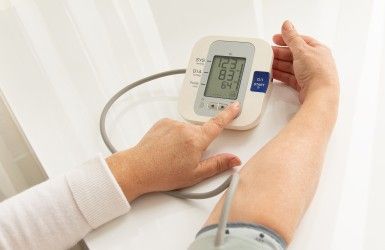General Health
Blood Pressure (BP) – Normal Range, Purpose, Procedure, And Results Interpretation
5 min read
By Apollo 24|7, Published on - 16 May 2025
Share this article
0
0 like

Blood pressure (BP) is a vital indicator of overall health, reflecting the force exerted by blood against the walls of arteries. It plays a critical role in assessing heart and vascular function, serving as a diagnostic tool for potential health risks, including hypertension (high blood pressure) and hypotension (low blood pressure). Regular monitoring of blood pressure can help identify issues early, enabling timely interventions to prevent severe complications such as heart disease, stroke, or kidney damage.
Purpose of Blood Pressure Monitoring
Monitoring your blood pressure regularly is a vital part of maintaining heart health and identifying problems before they become serious. It helps both patients and healthcare providers make informed decisions about treatment and prevention. The key purposes include:
- Early Detection of Issues: Routine monitoring helps spot high or low blood pressure early, even before symptoms appear. This allows for timely intervention to prevent long-term health risks.
- Prevention of Cardiovascular Complications: High blood pressure can quietly damage your arteries, heart, brain, and kidneys. Keeping an eye on your readings reduces the risk of heart attacks, strokes, and other serious conditions.
- Support for Treatment Planning: Your blood pressure readings provide valuable insights that help your doctor tailor treatment, whether it involves lifestyle changes, medications, or both.
- Monitoring Treatment Effectiveness: Regular checks help track how well your current plan is working and whether any adjustments are needed to keep your blood pressure within a healthy range.
Preparing for an Accurate Blood Pressure Measurement
To obtain a precise blood pressure reading, it's essential to follow these preparatory steps:
- Avoid Certain Activities: Refrain from smoking, consuming caffeine, or engaging in physical exercise for at least 30 minutes prior to the measurement.
- Use the Restroom: Empty your bladder before the test, as a full bladder can influence blood pressure readings.
- Relax Before Measurement: Sit quietly in a chair for a minimum of five minutes to allow your body to reach a resting state.
- Proper Posture: Ensure your back is straight and supported, with your feet flat on the floor and legs uncrossed.
- Arm Positioning: Rest your arm on a table or flat surface, keeping it at heart level. Avoid talking during the measurement to prevent any potential increase in blood pressure.
- Cuff Placement: Wear short sleeves or roll up your sleeves to expose your upper arm. The blood pressure cuff should be placed directly on your bare skin, not over clothing.
Procedure for Measuring Blood Pressure
There are two common methods used to measure blood pressure: manual and automated.
- Manual Measurement: In a manual reading, a healthcare professional uses a stethoscope and a device called a sphygmomanometer. The cuff is inflated using a hand pump until it temporarily stops blood flow in the artery. As air is slowly released from the cuff, the provider listens through the stethoscope placed over a major artery in your arm to detect the sounds of blood beginning to flow again. These sounds help determine the systolic and diastolic pressures, which are then recorded as your blood pressure reading.
- Automated Measurement: In an automated reading, a digital blood pressure monitor inflates the cuff and measures the pressure electronically. The machine automatically detects the pulse and provides a digital readout of your systolic and diastolic pressures. This method does not require a stethoscope and is commonly used both in clinics and for home monitoring.
Both methods are effective when performed correctly. Your healthcare provider will choose the most appropriate one based on the setting and your health condition.
Blood Pressure: Results Interpretation
Blood pressure is measured in millimetres of mercury (mm Hg) and consists of two numbers: systolic (the upper number) and diastolic (the lower number). The systolic pressure reflects the force exerted on the artery walls when the heart beats, while the diastolic pressure measures the force when the heart is resting between beats.
Blood Pressure Normal Ranges
For most adults, normal blood pressure is generally considered to be below 120/80 mm Hg. However, these ranges can vary based on factors like age and gender. Below is a breakdown of normal blood pressure ranges by age and gender:
General Blood Pressure Categories
Blood Pressure Normal Ranges by Age and Gender
Blood pressure norms can vary between men and women, especially as they age. Below is a table reflecting typical BP normal range for male and BP normal range for female age wise.
Abnormal Blood Pressure Levels
- Abnormal blood pressure levels can lead to significant health concerns and should not be ignored.
- High Blood Pressure (Hypertension): This condition increases the risk of serious issues like heart disease, stroke, kidney damage, and vision problems. Left unmanaged, it can have long-term effects on vital organs and overall health.
- Low Blood Pressure (Hypotension): While less common, low blood pressure can cause symptoms such as dizziness, fainting, and fatigue. In severe cases, it can result in insufficient blood flow to critical organs, potentially leading to complications.
Managing Abnormal Blood Pressure Readings
Effective management of abnormal blood pressure levels focuses on both lifestyle changes and medical interventions:
Lifestyle Modifications:
- Adopt a heart-healthy diet rich in fruits, vegetables, whole grains, and lean proteins.
- Exercise regularly, aiming for at least 150 minutes of moderate activity each week.
- Maintain a healthy weight to reduce strain on your heart.
- Avoid smoking and limit alcohol consumption.
Medical Treatment:
- Hypertension: Medications like ACE inhibitors, beta-blockers, or diuretics may be prescribed to lower blood pressure.
- Hypotension: Treatment depends on the underlying cause, which may involve medications, dietary changes, or other interventions.
Conclusion
Monitoring blood pressure is a crucial aspect of maintaining overall health and preventing serious complications. Whether you're managing high blood pressure, low blood pressure, or simply tracking your cardiovascular wellness, understanding the normal range, purpose, procedure, and interpretation of results equips you to make informed decisions. Regular check-ups and proactive management strategies can significantly improve your quality of life and long-term health.
General Health
Frequently Asked Questions
What is the BP normal range for male individuals?
What is the BP normal range for male individuals?
What is the BP normal range for male age wise?
What is the BP normal range for male age wise?
What is the BP normal range for female age wise?
What is the BP normal range for female age wise?
Why does age impact blood pressure?
Why does age impact blood pressure?
What is the normal BP range for a 70-year-old male?
What is the normal BP range for a 70-year-old male?
What is the normal BP range for a 40-year-old male?
What is the normal BP range for a 40-year-old male?
What is considered low blood pressure?
What is considered low blood pressure?
How can I maintain a healthy blood pressure?
How can I maintain a healthy blood pressure?
How frequently should I check my blood pressure?
How frequently should I check my blood pressure?
Do gender and age significantly affect blood pressure readings?
Do gender and age significantly affect blood pressure readings?
Leave Comment
Recommended for you
.jpg?tr=q-80)
General Health
ABC Juice Benefits: Why This Vitamin-Packed Juice Is Great for Overall Wellness?

General Health
Dengue Diet: What to Eat and Avoid in Dengue Fever?
Eating healthy, nutritious food can help fight most diseases. So, if you’re suffering from dengue fever and are wondering what to eat and avoid, read on to know more.dengue diet what to eat in dengue foods for dengue fever dengue food to eat and avoid foods to avoid in dengue dengue fever diet plan

General Health
Your Bleeding Gums Can Be A Sign Of Liver Disease! Know How
Your body experiences a plethora of different symptoms if you are suffering from fatty liver disease indicating that something is not right. Gum bleeding is one of the most common symptoms of a progressive liver disease called cirrhosis. However, it can be prevented easily with improved lifestyle changes.
Subscribe
Sign up for our free Health Library Daily Newsletter
Get doctor-approved health tips, news, and more.
Visual Stories

Science-backed Home Remedies for Burns and Blisters
Tap to continue exploring
Recommended for you
.jpg?tr=q-80)
General Health
ABC Juice Benefits: Why This Vitamin-Packed Juice Is Great for Overall Wellness?

General Health
Dengue Diet: What to Eat and Avoid in Dengue Fever?
Eating healthy, nutritious food can help fight most diseases. So, if you’re suffering from dengue fever and are wondering what to eat and avoid, read on to know more.dengue diet what to eat in dengue foods for dengue fever dengue food to eat and avoid foods to avoid in dengue dengue fever diet plan

General Health
Your Bleeding Gums Can Be A Sign Of Liver Disease! Know How
Your body experiences a plethora of different symptoms if you are suffering from fatty liver disease indicating that something is not right. Gum bleeding is one of the most common symptoms of a progressive liver disease called cirrhosis. However, it can be prevented easily with improved lifestyle changes.